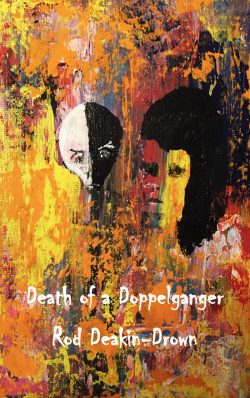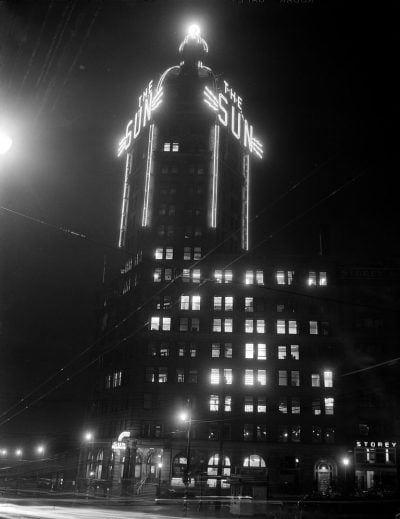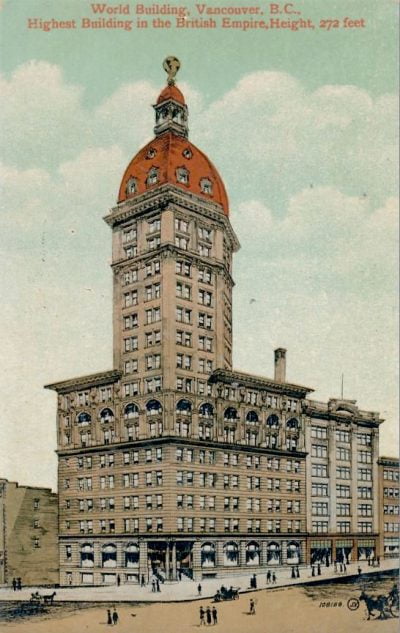#879 Murder on the Sun Tower
Death of a Doppelganger
by Rod Deakin-Drown
New Westminster: Silverbow Publishing, 2019
$23.95 / 9781774030714
Reviewed by Ben Matthews
*
 Rod Deakin-Drown’s Death of a Doppelganger is a classic noir mystery set in modern-day Vancouver. It begins with a murder that happens just before we meet the protagonist, Count Jason Kereso. Kereso is a private investigator. At the end of one day, a strange man calling himself Lorne Paddon appears in Kereso’s office, claiming to have seen one man kill another atop the Sun Tower in downtown Vancouver. From the beginning, Kereso knows that something is off with Paddon. The man walks with a limp that seems, and is eventually proven to be, faked. He wears a cloak. He is odd. But he is an actor, so maybe that explains it.
Rod Deakin-Drown’s Death of a Doppelganger is a classic noir mystery set in modern-day Vancouver. It begins with a murder that happens just before we meet the protagonist, Count Jason Kereso. Kereso is a private investigator. At the end of one day, a strange man calling himself Lorne Paddon appears in Kereso’s office, claiming to have seen one man kill another atop the Sun Tower in downtown Vancouver. From the beginning, Kereso knows that something is off with Paddon. The man walks with a limp that seems, and is eventually proven to be, faked. He wears a cloak. He is odd. But he is an actor, so maybe that explains it.
Regardless, Kereso does not believe Paddon’s claim of witnessing a murder. The next day, however, Kereso’s assistant, Farrah Johnson, sees Paddon himself get murdered in the street. Suddenly, the murder Paddon claimed to witness becomes far more relevant, and we are left with a burning question: who was the man who was murdered atop the tower? If the story focused on this question, it would fit nicely into the slow-burn mystery of the black and white film noirs of the forties and fifties. Indeed, the portions that focus on this question are fun, comporting themselves with a screwball energy that is both engaging and entertaining. These supply the burn portion of the slow burn formula.

Unfortunately, Deakin-Drown spends an excessive amount of time on subplots, which add very little to the story. Here, the slow portion of the formula is overemphasized.
One subplot involves the estranged husband of Farah Johnson and some stolen money, and seems to exist for no reason at all. Its existence is never justified nor reconciled with the main plot.
The other subplot has to do with Kereso’s love interest, Anna Christina. Christina is having an affair with Kereso. It has been going on for some time, and she has nothing but admiration for Kereso and nothing but contempt for her husband, whom she charmingly refers to as “limp-Steve.” It is here that Deakin-Drown’s narrative slows to a crawl. Kereso and Christina’s intimate meetings are laid out in excruciating detail but serve little purpose other than to show that they are in a relationship and that she hates her husband. The central mystery is shoved into the background for long stretches so that we can watch these two have pillow talk.

These interludes do nothing to garner any audience sympathy for the duo. Christina is shown to be cruel and malicious on more than one occasion. When her husband confronts the two of them during one of their trysts, she dismisses him in a callow and cold manner. It is not a scene that has the power to accompany the fiery end of a fifteen-year marriage. Worse, I suspect that we are supposed to cheer for Christina, but we have no reason to despise Steve as much as she does. As far as I could tell, his only crime was not being man enough for Christina. Lucky for her, Kereso is man enough for her. Or so we are told, anyways. Kereso takes the whole ordeal in stride, approaching the situation with a detachment that borders on apathy.
At least by having the confrontation, the main plot is allowed to move forward. However, now Christina starts to accompany Kereso everywhere as he attempts to unravel the mystery of Paddon and the murdered man. It is lucky for Kereso that she does accompany him because he does not seem to have the skills that one would think would be necessary in a private investigator. He can’t use a computer. His network of informers seems to consist of one reporter who is almost out to pasture. “How do you find anyone?” Christina asks him at one point. I wondered the same thing! They track down an old landlady of Paddon’s after finding a letter randomly in a place they happened to be for no reason. She tells them a bit about Paddon’s backstory, and we find out about a woman named Perlita. The next day, they find the landlady murdered. Instead of calling the police, they tamper with the crime scene by stealing some letters and leaving the old lady’s dead body in the house.

Kereso and Christina meander through the plot in this manner for the rest of the book. At some point we learn that Paddon was part of a plan to find out more about Kereso and Christina’s affair because he was connected to Steve, her husband, in some way that was so convoluted that it stretched my belief past its breaking point. Deakin-Drown attempts to tie all the loose threads together at the end of the book by having Perlita show up and explain everything, but by this point, the coincidences are too numerous and too profound to be believed.
Not that any of this matters, for at the end of the book we find out that the main plot was a red herring distracting us from another plotline that we had no idea was happening anyway. This plotline involved stolen documents, international intrigue, and the eponymous doppelganger. Sounds interesting – but it would have been nice if there had been more than three pages dedicated to it.
This novel is Deakin-Drown’s first foray into fiction. He has previously published poetry and non-fiction and shows a deft hand in describing Vancouver’s landmarks and history. The city is a fine backdrop for the story, and the loving detail in which it is portrayed helps ground much of the story in the realism the story requires. If you are familiar with the city, you will smile as you recognize the landmarks and appreciate the little tidbits of history that Deakin-Drown sprinkles throughout.
At the end of the day, there is a fun little mystery hidden within the novel. If you put on your investigator hat, you might enjoy sifting through the clues to find it.
*

Benjamin Matthews works as a consultant in heavy industry while studying for a double major in Psychology and English at Thompson Rivers University. He is an avid reader, writer, and cinephile, always on the lookout for a good story. Editor’s note: previously, for The Ormsby Review, Ben reviewed Sodom Road Exit, by Amber Dawn.
*
The Ormsby Review. More Books. More Reviews. More Often.
Publisher and Editor: Richard Mackie
The Ormsby Review is a journal service for in-depth coverage of B.C. books and authors. The Advisory Board consists of Jean Barman, Robin Fisher, Cole Harris, Wade Davis, Hugh Johnston, Patricia Roy, David Stouck, and Graeme Wynn. Scholarly Patron: SFU Graduate Liberal Studies. Honorary Patron: Yosef Wosk. Provincial Government Patron since September 2018: Creative BC
“Only connect.” – E.M. Forster
2 comments on “#879 Murder on the Sun Tower”
Ben Matthews’ just-out review of my Vancouver-based mystery novel, Death of a Doppelganger is going to be very helpful – both in selling the book and in my making improvements in Doppeganger’s follow-up, Escape from Purgatory. Matthews is a very capable writer and a good critic, and I appreciate his engagement with my book. He might well also be a rarity in the review biz — a critic whose suggestions are subtle, interesting, and useful. He LIKED my book, although he found some parts too “off-formula” for his taste. My response: I think the more intriguing mystery is at times found in the moral and ethical conundrums my characters stumble into — and how they get out of them. Matthews praised the main plot: who was the man killed during a struggle atop the Sun Tower, one of Vancouver’s premier heritage buildings? Or was he killed? Or was there even a murder? Matthews liked it when, in his opinion, I stuck to the noire formula of 1940s mystery novels. He was less happy with my “sub-plotting,” thinking it slowed down the narrative. But he liked how I “back-grounded” Vancouver neighbourhoods and memorable sites into the narrative: “[Deakin-Drown] … shows a deft hand in describing Vancouver’s landmarks and history. The city is a fine backdrop for the story, and the loving detail in which it is portrayed helps ground much of the story in the realism the story requires. If you are familiar with the city, you will smile as you recognize the landmarks and appreciate the little tidbits of history that Deakin-Drown sprinkles throughout.” In his summary paragraph this very capable critic shows his affection for my debut novel: “At the end of the day, there is a fun little mystery hidden within the novel. If you put on your investigator hat, you might enjoy sifting through the clues to find it.”
I also appreciated Ormsby editor’s Richard Mackie’s choice of prime Vancouver heritage sites photos that he inserted into the review. Thanks to both these gentlemen for their jobs well done!
People wanting to buy Death of a Doppelganger can do so by contacting me at rpdrown@hotmail.com The princely sum of $29 will get your copy sent to you anywhere in Canada. Books can also be obtained from the publisher, Candice James, at Silver Bow Publishing silverbowpublishing@gmail.com